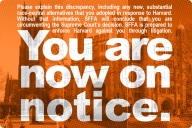You have /5 articles left.
Sign up for a free account or log in.
In November 2014, I marched the streets of Chicago with my partner and many others in response to a grand jury’s decision not to indict a police officer in the shooting death of Michael Brown in Ferguson, Mo. I did not do so easily. And yet, I walked.
I was a college president.
I knew that Amy Gutmann, president of the University of Pennsylvania, had lain down with students performing a die-in at her home and said, “Black lives matter.” And I knew that controversy swirled around her choice.
I knew that predecessor presidents, in the 19th and 20th centuries, had used their prestige, moral stature and bully pulpits to take stands around much more than the higher education reauthorization bill or the role of financial aid. Some of their positions appall me -- and some seem to me to have been right. Most crucially, their willingness to speak to public issues of import that were both directly and less directly relevant to their immediate mission and job descriptions inspire me. They make me think about what has changed in the role of the college or university president in more recent years.
As I look back to November 2014, I know that my uncertainty about marching came in part from forces that shape today’s college presidency: the need to raise money, the complexities of admissions and enrollment marketing, financial storms, board leadership, social media eruptions that end presidencies, and much more. Of course, I was also concerned about the relevance of performative or expressive politics rather than policy change. But, I admit: it was mostly worry about my then institution and role that hampered me.
Then, as now, I asked myself what it might mean to be an inside leader with outside values -- a college president who remains responsible both to the institution and its many constituencies and to the broader concept of citizenship and higher education’s claim to shape the public good. Had I, perhaps voluntarily, given up my freedom of speech or academic freedom by taking on the role of president?
What was the relation between my institutional role and my own views as scholar or citizen? Seeing higher education as contributing more than the simple sum of our impact on individuals, I wondered why we as presidents seem so silent. Yes, we have lobbying organizations in Washington -- a whole alphabet soup of them -- and many of us write op-eds and speak in various venues to the value of what we do. And yet …
I also asked myself about outsider -- or, to use Malcom Gladwell’s oft-repeated terminology -- outlier colleges and universities like the one I led in 2014, Shimer College. That institution was outside the mainstream of higher education in terms of various markers, including our very progressive values. Was our -- or my -- capacity to disagree with the powers that be in some arenas possible because we were so fragile in other ways? So, dare I say it, tiny and potentially irrelevant, allowing me to slip beneath radar screens as, for example, my peers elsewhere could not?
Today, my uncertainties remain.
I know what I have done when it comes to public speech as a college president. I am proud that I walked with those who knew the Ferguson decision was a negative judgment on our country’s capacity to address matters of race and policing. And I am proud of the letters I’ve signed, statements I’ve made and campus policies I’ve sought to bring forward. Like other presidents, I have signed on to statements about DACA and guns on campus, for example. I have supported other presidents who took on issues like divestment and boycotting with their boards, rescinded honorary degrees from sexual predators, and filed amicus briefs or engaged in lawsuits about matters of educational and public concern. I have written op-eds rejecting Religious Freedom Restoration Act laws and arguing against gun violence. I have worked to identify how to divest higher education advertising dollars from venues supporting white supremacy and advocated for refusing National Rifle Association dollars.
Such matters seem more and more urgent today, as the economic situation of higher education declines; as matters of central concern to civil society such as free speech, diversity, freedom of the press and education itself are under attack -- and as racism, misogyny and other bigotries are on the rise; our roles in shaping lives and civil society are undervalued and misunderstood; and, perhaps, our impact is weakening. The situation facing us today is more serious than it was even in November 2014. I know many of my former peers have been important voices in opposing the Muslim travel ban, refusing support from corporations benefiting from child internments, supporting racial justice and making evident our commitment to the rights of the LGBTQ community while fighting on other fronts to sustain the best of what American higher education has been and can be.
Today I ask, however, not what can we do but what must we do?
I remain unsure where the line in the sand is for myself and for college presidents more generally. Yet I know we must not ignore the question. Leadership, perhaps, is the willingness to struggle in public -- and to do so strategically so that our uncertainty does not mean we do too little, or act too late, in the face of well-organized hostility. This is our time and our responsibility.
From today’s vantage point, I would say: we must do more. All of us.








